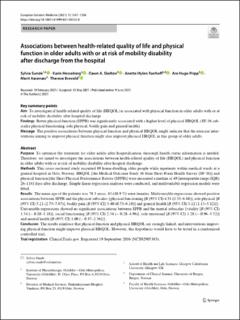| dc.contributor.author | Sunde, Sylvia | |
| dc.contributor.author | Hesseberg, Karin | |
| dc.contributor.author | Skelton, Dawn A. | |
| dc.contributor.author | Ranhoff, Anette Hylen | |
| dc.contributor.author | Pripp, Are Hugo | |
| dc.contributor.author | Aarønæs, Marit | |
| dc.contributor.author | Brovold, Therese | |
| dc.date.accessioned | 2022-04-12T09:32:57Z | |
| dc.date.available | 2022-04-12T09:32:57Z | |
| dc.date.created | 2021-07-06T12:02:19Z | |
| dc.date.issued | 2021 | |
| dc.identifier.issn | 1878-7649 | |
| dc.identifier.uri | https://hdl.handle.net/11250/2991039 | |
| dc.description.abstract | Purpose
To optimise the treatment for older adults after hospitalisation, thorough health status information is needed. Therefore, we aimed to investigate the associations between health-related quality of life (HRQOL) and physical function in older adults with or at risk of mobility disability after hospital discharge.
Methods
This cross-sectional study recruited 89 home-dwelling older people while inpatients within medical wards at a general hospital in Oslo, Norway. HRQOL [the Medical Outcome Study 36-Item Short-Form Health Survey (SF-36)] and physical function [the Short Physical Performance Battery (SPPB)] were measured a median of 49 [interquartile range (IQR) 26–116] days after discharge. Simple linear regression analyses were conducted, and multivariable regression models were fitted.
Results
The mean age of the patients was 78.3 years; 43 (48.9 %) were females. Multivariable regressions showed positive associations between SPPB and the physical subscales {physical functioning [B (95% CI) 4.51 (2.35–6.68)], role physical [B (95% CI) 5.21 (2.75–7.67)], bodily pain [B (95% CI) 3.40 (0.73–6.10)] and general health [B (95% CI) 3.12 (1.13–5.12)]}. Univariable regressions showed no significant associations between SPPB and the mental subscales {vitality [B (95% CI) 1.54 (− 0.10–3.18)], social functioning [B (95% CI) 2.34 (− 0.28–4.96)], role emotional [B (95% CI) 1.28 (− 0.96–3.52)] and mental health [B (95% CI) 1.00 (− 0.37–2.36)]}.
Conclusion
The results reinforce that physical function and physical HRQOL are strongly linked, and interventions improving physical function might improve physical HRQOL. However, this hypothesis would have to be tested in a randomised controlled trial. | en_US |
| dc.language.iso | eng | en_US |
| dc.publisher | Springer | en_US |
| dc.rights | Navngivelse 4.0 Internasjonal | * |
| dc.rights.uri | http://creativecommons.org/licenses/by/4.0/deed.no | * |
| dc.title | Associations between health-related quality of life and physical function in older adults with or at risk of mobility disability after discharge from the hospital | en_US |
| dc.type | Journal article | en_US |
| dc.type | Peer reviewed | en_US |
| dc.description.version | publishedVersion | en_US |
| dc.rights.holder | Copyright 2021 The Author(s) | en_US |
| cristin.ispublished | true | |
| cristin.fulltext | original | |
| cristin.qualitycode | 1 | |
| dc.identifier.doi | 10.1007/s41999-021-00525-0 | |
| dc.identifier.cristin | 1920456 | |
| dc.source.journal | European Geriatric Medicine | en_US |
| dc.source.pagenumber | 1247–1256 | en_US |
| dc.identifier.citation | European Geriatric Medicine. 2021, 12, 1247–1256. | en_US |
| dc.source.volume | 12 | en_US |

